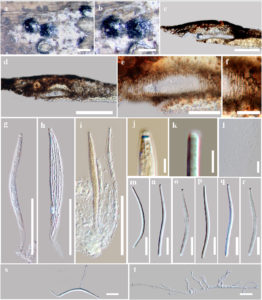Linocarpon cocois Konta & K.D. Hyde, in Konta, Hongsanan, Liu, Eungwanichayapant, Jeewon, Hyde, Maharachchikumbura & Boonmee, Mycosphere 8(10): 1965 (2017)
Index Fungorum number: IF 553961
Etymology – The specific epithet refers to the host genus Cocos
Holotype – MFLU 15–2345
Saprobic on rachis of Cocos nucifera L. Sexual morph: Ascomata 73–184 μm high × 400–980 μm diameter (x̅ = 124 × 655 μm, n = 10, up to 1,000 μm), solitary or aggregated, superficial, comprising shiny, black, dome-shaped, raised blistering areas, subglobose, flattened at the base, central ostiole. Peridium 60–92 μm diameter (x̅ = 71 μm, n = 10), outer cells merging with the host epidermal cells, composed of dark brown to black, cells of textura angularis. Hamathecium comprising numerous, 0.5–1 μm diameter (x̅ = 0.7 μm, n = 10), hyaline, septate, hypha-like paraphyses, longer than asci. Asci 100–153 μm × 8–15 μm (x̅ =120 × 10 μm, n = 20), 8-spored, unitunicate, cylindrical, long-pedicellate, with a J-, wedge-shaped, subapical ring. Ascospores 69–90 × 3–5 μm (x̅ = 76 × 4 μm, n = 20), parallel when immature, becoming spiral at maturity, filiform-fusiform, straight or curved, hyaline, aseptate when mature, becoming multi-septate when germinating, without refringent septum-like bands, ends rounded, the base wider than apex, smooth-walled, with a mucilaginous appendage at the apex, producing germ tube from each cell. Asexual morph: Undetermined.
Culture characters – Ascospores germinating on MEA within 24 hours. Colonies on MEA reaching 7–8.5 cm diameter after 2 months at 25°C, white at the edge with strong radiations outwards. After 30 days of incubation, colonies smooth, flat, entire edge margin, brown, hyphae septate, branched, smooth.
Material examined – THAILAND, Prachaupkhirikan Province, Sai Khu Water Fall, on dead rachis of Cocos nucifera L. (Arecaceae), 30 July 2015, Sirinapa Konta PJK04f (MFLU 15–2345, holotype); HKAS100701, isotype; ex-type living culture, MFLUCC 15–0812.
Notes – Linocarpon cocois is morphologically similar to Linocarpon genus in its black, dome-shaped, raised blistering areas, flattened at the base, with a central ostiole. Phylogenetically L. cocois groups together with L. arengae (Fig. 1). In addition, our L. cocois isolate has been collected from the same family host (Arecaceae) with L. arengae but has been collected from Cocos nucifera and Arenga pinnata. Linocarpon pandanicola, on the other hand, has been isolated from Pandanaceae. Although L. cocois is closely related to L. arengae, it differs in having ascospore shape, size, lacks the refringent septum-like bands and differ in the shape and the type of appendages.

Fig 1. Linocarpon cocois (MFLU 15–2345, holotype). a Ascomata on host substrate. b Close up of ascomata. c–e Sections of ascomata. f Peridium. g–i Asci. j J- reaction of apical ring. k Appendage. l Paraphysoids. m–r Ascospores. s–t Germinated ascospores. Scale bars: a, b = 500 μm, c, d = 200 μm, e, g–i = 50 μm, j, k = 5 μm, f, l–t = 20 μm
